ECOFLOW River Review: Don’t Buy before you read this
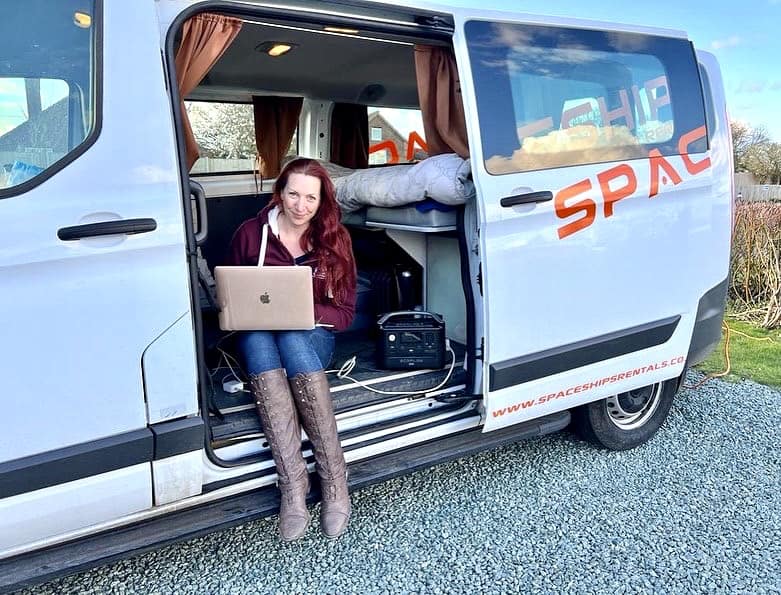
Recently, I reviewed the Jackery Explorer 500. Very shortly afterwards, Ecoflow contacted me and suggested I might be interested in reviewing their River 600 Max powerbank.
I’ll be honest, I was intrigued. Jackery are prolific in their marketing, but I’ve heard a lot of great things about the Ecoflow units too, especially the newer generation.
So I thought I’d find out for myself and see how they compared…
DISCLAIMER: Ecoflow supplied us with the Ecoflow River Max free of charge, on the strict understanding we would return the kit if we didn’t think it was worth reviewing. We received no other compensation for this review and all opinions are entirely our own.
And, while we’re doing disclaimers…
*We work hard to make this the best motorhome travel blog and road trip website possible, full of helpful content for you. The website is supported by our readers, so if you buy through links on this site we may earn a commission- at no extra cost to you. All opinions remain our own.
If you find this post useful, you can also treat us to a coffee – we promise to enjoy it while creating more useful content like this- we might even indulge in a biscuit (or two!)
Ok, now that all the legal stuff is out the way, let’s get on with this Ecoflow River Max review.
JUMP AHEAD TO...
Portable Powerbanks- why are they useful in a motorhome, RV or campervan?
Let’s start with the ‘why’. When you have so many other essential motorhome accessories and probably already have a solar panel fitted to your van (as well as a leisure battery), why do you need a portable power bank?
The answer is, if you’re ONLY ever planning to use campsites with electric hookup, you probably don’t. Save the weight on the payload and spend your money elsewhere.
HOWEVER…
If you enjoy, or want to try spending time off-grid/ wild parking with your motorhome or campervan, or even staying at campsites which don’t have electric (like grass fields near a beach), then you will more than likely need a way of creating, storing and using electricity while you’re ‘off-grid’.
Don’t forget to grab your free motorhome wild camping checklist here to help you set up your van to stay overnight without electricity or facilities.
Some people install a second leisure battery onto their van, which is fine but leaves you with the same constraints as before. You’ll also need an inverter to be able to use the battery power to charge your devices.
Working outside
The biggest drawback we’ve found with having a fitted battery instead of a portable power bank is that you can’t use it outside. Personally, I LOVE working outdoors whenever possible- part of the magic of travelling in remote places. But to do that, you need something portable you can take outside with you.
NOTE: The Ecoflow power stations aren’t built for hiking with. They’re quite large and fairly hefty. Think of it more like a second, moveable leisure battery. Having said that, you CAN detach the Ecoflow ‘bottom’ battery, which makes it a lot lighter and more portable.
Why do we need a portable power station?
Personally, both myself and my husband work from the road. We use a LOT of power. Between us, we have two laptops, 3 ipads, 4 phones, plus a drone, camera, wifi and several other devices which need power to recharge.
When we’re driving all the time, it’s easy- we charge things as we drive using an inverter. However, when we’re camped up in one place for a few days (like at the top of Tre Cime in the Dolomites), we need a way of creating electricity for all our devices.
Yes, we carry a portable motorhome generator, but that’s noisy and pretty heavy. You also need to carry fuel for it. We do have a small power bank, but it’s now 6 years old and isn’t holding its charge so well. So a portable power bank like the Ecoflow has a lot of advantages.

Benefits of a solar-powered power station over a normal generator
There are some HUGE advantages to having a solar-powered system over a fuel-powered one (and a couple of disadvantages too.)
PROS of a portable solar generator:
- Quiet- no noisy engine
- No need to carry fuel cans- easier to store (some countries like Portugal make it illegal to carry fuel cans)
- Cheaper to run- solar is free!
- No smell of fumes
- Better for the environment
- Doesn’t need maintenance – great for motorhomes and vans which are used as holiday vehicles.
- Quick and easy to set-up and safe to use
CONS of a portable solar generator:
- Need to store the solar panels somewhere safe
- Sunshine is essential if you want to charge and you’re off-grid.
Who are Ecoflow?
EcoFlow began as a group of former DJI engineers. They ended up raising millions on Kickstarter and Facebook to develop new powerbanks and technology which could run without fuel.
Although they’ve only been around since 2016, the technology and products are already touted as one of the market leaders for renewable power sources.
They offer a range of portable power stations/ home batteries, including the Ecoflow Delta and Ecoflow River Series. They also offer solar panels, solar generators and other accessories
Ecoflow River Max Review: What’s in the box?
When you open your River Max box, you’ll find the following:
- EcoFlow RIVER Portable Power Station
- DC5521-DC5525 Cable
- 1.5m MC4 to XT60 Solar Charging Cable
- 1.5m AC Charging Cable
- 1.5m Car Charging Cable
- User Manual
- Warranty Card
I really liked how the unit was presented and how it worked straight out of the box. Also, I was pleased with the packaging; very secure, very little plastic and not lots of wasted space.
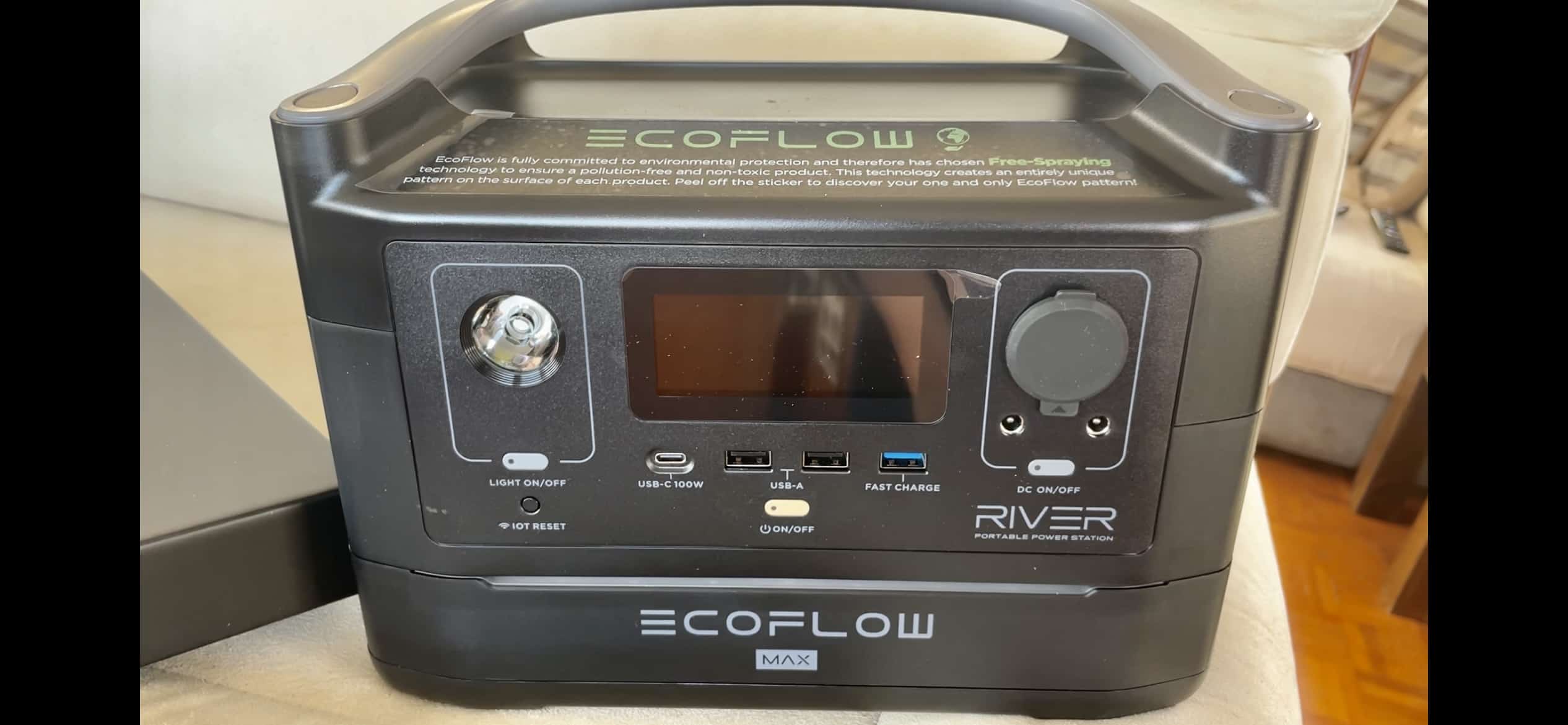
Ecoflow River Max Specification
We were sent the Ecoflow River Max portable power station. The specs of this unit are:
- Net Weight: 17 lbs (7.7kg)
- Dimensions: 11 x 6.9 x 8.8 in (28 x 17.5 x 22.5 cm)
- Charge Temperature: 0 to 45°C (± 3°C)
- Discharge Temperature: -20 to 45°C (± 3°C)
- Capacity: 576Wh
- Cycle Life: 500 Cycles to 80%+ capacity
- Types of outlets: 2 x AC, 2 x USB-A, 1 x USB-C, 1 x USB-A Fast Charge, 1 x Car Power Output
- Charging Methods: AC Wall Outlet, 12V Car Charger, Solar Panel
- Battery Type: Lithium-ion
- Shelf Life: 1 year (after fully charging the device)
- Warranty: 24 months
What Management systems/ protections does the Ecoflow River 600 have?
Over Voltage Protection, Overload Protection, Over Temperature Protection, Short Circuit Protection, Low Temperature Protection, Low Voltage Protection, Overcurrent Protection
See the Ecoflow River Max in action
Watch the video below to see me using the Ecoflow in a campervan (and using it to power my electric blanket!)
We hope you found the video useful. If you did, we’d love it if you followed us on Youtube. New videos with tips for motorhoming and campervanning in the UK and Europe are released weekly.
How long does it take to recharge the EcoFlow River Max?
To be honest, not long at all- although of course how long the unit will take to recharge will depend on the method used to recharge it.
Ecoflow are very proud of the fact that you can get from 0-80% charge in under one hour using AC wall charging and their special ‘X-Stream’ technology. Having discharged and re-charged the unit a few times, I can confirm that it is super fast to charge up again, which is fantastic in a world like motorhoming when you’re trying to get power as quickly as possible.
Rough guides are as follows:
- AC (wall charging): Approx 1.6 Hours
- 12v Car Charger (cigarette lighter socket): 6.5 Hours
- Using 2 x 110W Solar Panels simultaneously in full sunlight: 3-6 Hours
- Using 1x160W Solar Panel with full sun: 4.8-9.6 Hours
The inputs/ voltage for charging are as follows:
- AC Charge Input Voltage: 220-240Vac (50Hz/60Hz)
- Solar Charge Input: 200W 10-25V DC 12A max
- Car Charger Input: 12V DC 8A max
And the spec for the outputs on the River Max are:
- AC Output (x2): 600W (Surge 1200W) total, 230Vac (50Hz/60Hz)
- USB-C Output (x1): 5V DC,9V DC,12V DC,15V DC,20V DC,5A,100W Max
- USB-A Output (x2): 5V DC,2.4A,12W Max, per port
- USB-A Fast Charge (x1): 5V/2.4A,9V/2A,12V/1.5A 18W Max
- Car Power Output (x1): 136W, 13.6V DC, 10A Max
- DC5521 Output (x2): 13.6V DC, 3A Max, per port
River Max vs River Pro
Many people are a little confused about the differences between the Ecoflow River Max and the River Pro.
There are actually 3 products in the ‘River’ range and they are built to handle different requirements.
The RIVER is designed to be lightweight and provide “grab-and-go power”. The RIVER Max is the next level up, and includes an extra battery (which you can remove to go more lightweight.) The RIVER Pro is created for people who need even more capacity for off-grid, long haul adventures.
If you’re going to be doing a lot of wild camping/ staying off-grid with your van and have a lot of electronic devices to power, you might want to invest in the River Pro, but honestly the River Max has been great for us.
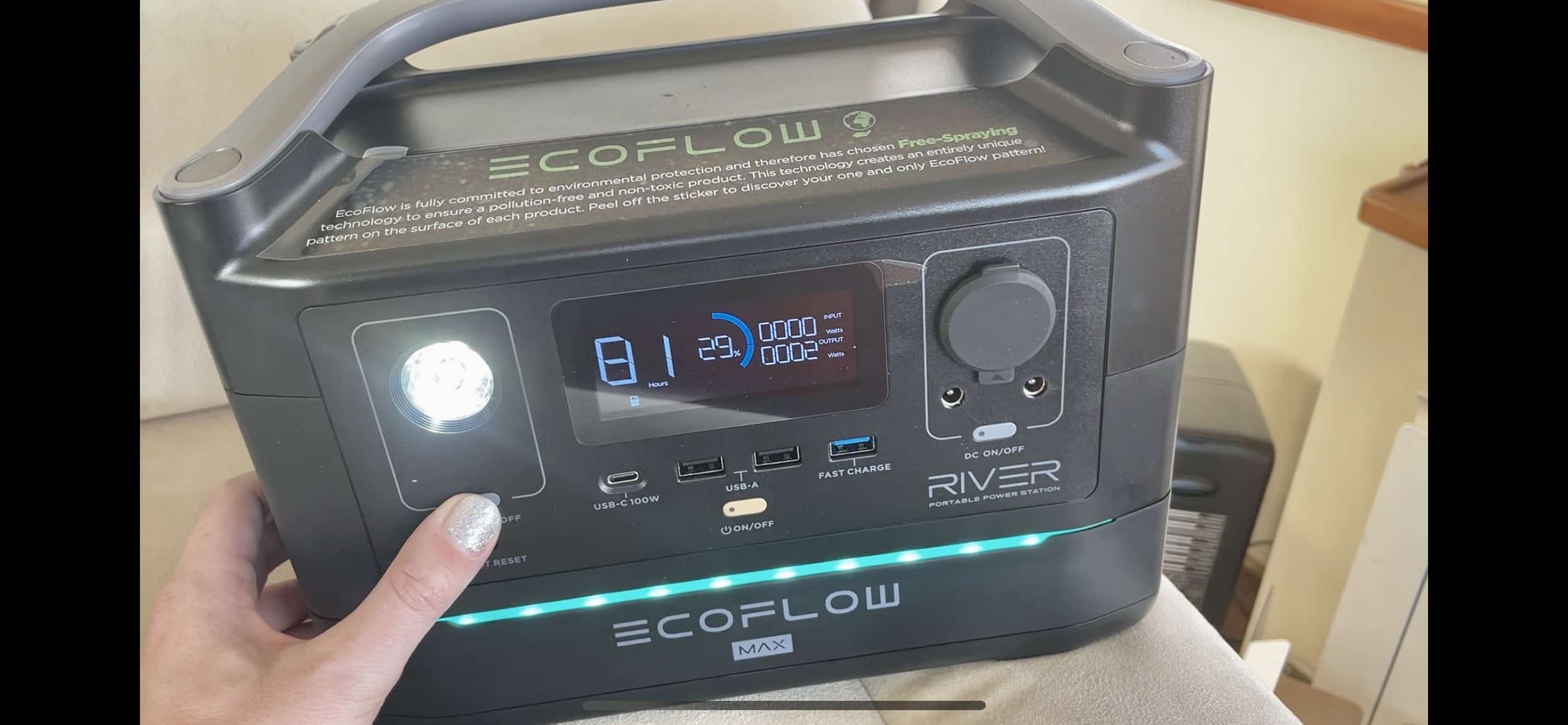
Ecoflow River 600- pros and cons
So, what’s it like actually using the River Max?
Pros of the Ecoflow River Max
The answer, in a nutshell, is easy. Straight out of the box, it worked and has continued to work ever since.
I even took it to Norfolk with me and ended up in -4c temperatures. The Ecoflow powered my electric blanket every single night and honestly was my lifesaver. I also used it to power a small electric heater AND it charged up my laptop several times without needing a recharge.
I love the wide array of sockets and that you can use them all at the same time AND they’ve positioned them cleverly, so you can plug in oversize plugs without worry.
NOTE: You need to turn the unit on, and then TURN ON the AC plug sockets before they’ll work. This can be a bit of a pain if you forget, because you then need to remove the plug, but it takes less than a second to do.
I am also a BIG fan of how quickly it recharged. In my experience, it took around 70-80 minutes to get back to 80% charge, but the conditions were REALLLLLLLLY cold, so I’ll let them off. Compare this to the Jackery, which would have taken several hours, and you’ll see why I liked the Ecoflow so much. In the time it took to grab a coffee, it was pretty much recharged again.
I love the LCD display- I found it clear and easy to understand. I liked knowing what watts I was drawing/ charging and how long I had until the battery was flat. Even better, the battery didn’t ‘wane’- you can power 600w all the way until the battery reaches 0%
Cons of the Ecoflow River 600 Max
However, there are a few things to be aware of:
- No case is included; you need to buy that separately
- It’s not waterproof. At all. So keep undercover in damp conditions
- I actually quite like the light effect on the Ecoflow, but some may find it annoying (although you can control this on the app.)
- Only lasts for 500 cycles. And there’s no way to replace the batteries. If you live in your van and charge it every 3 days, that’s only 1500 days (just over 4 years). It might be worth getting the River Pro in this case, which has a much longer life.
I don’t know if this is a downside, or just a point to note, but you need to turn on the unit in order to use the torch, which is a bit of a pain in the dark when you’re freezing cold and trying to figure out which button to press (ask me how I know…!)
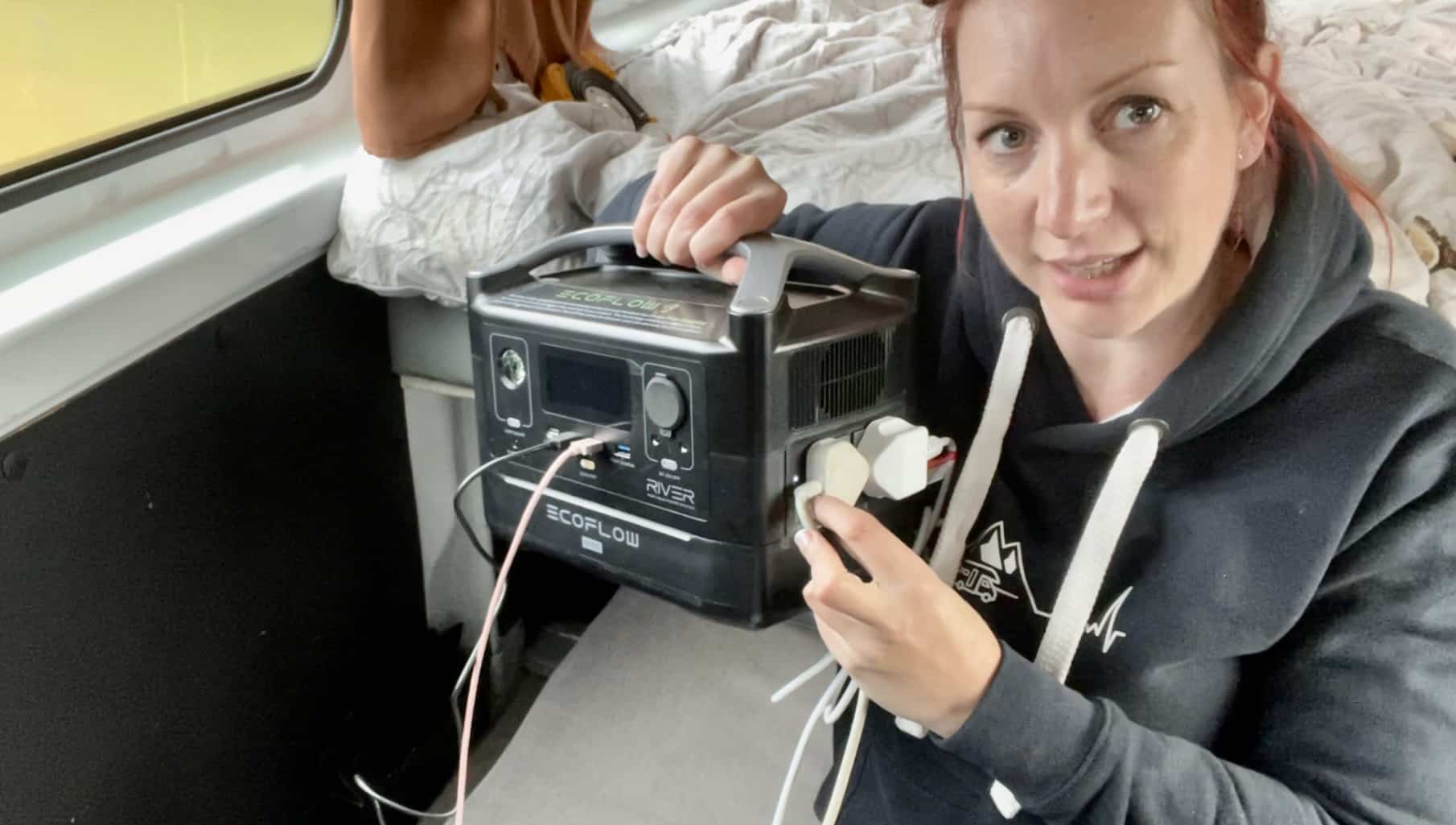
How long does the Ecoflow River last?
This is obviously a ‘how long is a piece of string question’. If you don’t power a lot of devices, the Ecoflow River Max is going to last weeks. If you have huge amounts of things to charge, it’s going to run out pretty quickly.
You can charge up to 9 devices simultaneously, and it doesn’t matter whether you charge them one at a time or all at once, the amount of power drained will be the same.
Here are some guidelines for you:
- Macbook Air (my laptop): 10 recharges
- Phone: 42 recharges
- 1200w Hairdryer: 0.8 hours (yes, it can power up to 1800w devices for a short time)
- 110w motorhome Television: 4-6 hours
- 40w CPAP machine: 10 hours
- 65w projector: 6 hours
You can choose to unbolt the bottom of the unit, which will remove the second battery. This makes the unit smaller and lighter (if you want to hike with it), but obviously will decrease the length of time you can use it for.
Ecoflow X Boost- what is it?
Ecoflow units use something called ‘x-boost’, which allows you to use devices over 600w.
Sort of.
Now, I’m in no way an electrician, so let me try to explain this to you in simple terms.
One of the biggest issues with life on the road for a girl is using a hairdryer, and most inverters/ power banks couldn’t even DREAM of powering a decent hair dryer (no, the 12v ones do not work on long, thick hair!)
So you can imagine how excited I was when I learned the Ecoflow might be able to power one for me.
Let me be clear, if you just plug in a 1200w+ hairdryer into the Ecoflow and use it, the unit will shut down and say ‘Overload’.
HOWEVER, on the app, you can turn on ‘X-Boost’, which means it can power devices above 600w but at a much lower power. Here are some useful things to know:
- X Boost doesn’t increase the output of the unit, it LOWERS the power of the device being used. So it will run the hairdryer on about ‘half’ power, so it may take longer to dry your hair than you might expect.
- Only power one device at a time using X-Boost
- Don’t use it while charging, especially from a wall.
Ecoflow Solar panel
Ecoflow offer a range of solar panels to go alongside most of their products.
With the River Max, you can connect up to two 110w solar panels and they (assuming they have full sunlight), will recharge the unit in under 3 hours.
They also now offer a 160w solar panel, which will recharge it a little faster (assuming full sunlight).
- [Fastest Charging in the Industry] Fully…
- [Power 80% Of Your Appliances] With an…
- [LFP Long-Life Battery] Using LFP…
- [Fast Solar Charging] Use clean, green…
Ecoflow App
Ecoflow have an app, which you can use to control the unit from your phone. I’ll be honest, I didn’t use the app at all for the first few weeks- it’s perfectly possible to use the unit without the app. However, there are some advantages to using it.
Firstly, this is how you’ll need to upgrade firmware for the unit, which is useful. You can also turn sockets on/off and turn on/ off the X-Boost via the app (I wish you could do this on the unit itself).
These are the instructions to set up the app:
- Step 1: Download the EcoFlow App & connect to the RIVER Max.
- Step 2: Turn the RIVER Max on.
- Step 3: Turn the WiFi on your phone/ device on
- Step 4: Find your device in the app. Then, you can start controlling your RIVER Max remotely.
NOTE: You need Wifi to set this up, or a hotspot if off-grid.
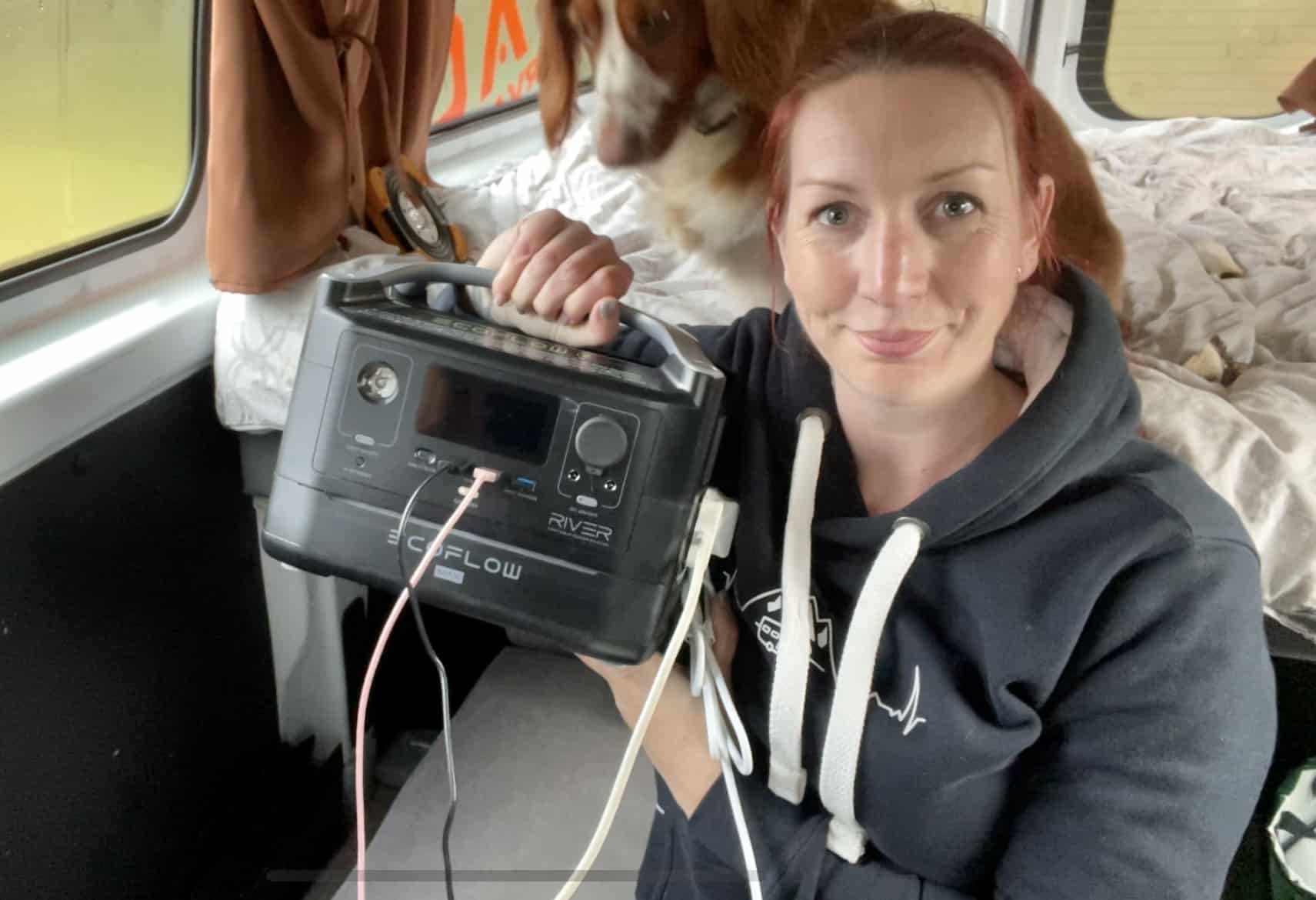
Ecoflow River vs Jackery | Which is better?
Ahhh, the million dollar question. If you’re in the market for a portable power bank or power station, should you buy an Ecoflow or a Jackery?
Like anything, there are pros and cons to both. My husband LOVES the Jackery. He uses it all the time at his motorcycle storage unit.
Still, there are some things which are undeniably better about the Ecoflow River Max over the Jackery:
- Faster charge time. Much MUCH faster
- Two AC plug sockets
- USB-C socket (which I use all the time)
- The unit works even when the main display is switched off (useful at night)
- 600w (and can power devices above this) instead of 500w
Personally, I prefer the Ecoflow. It suits the way I live off-grid better. However, the Ecoflow is heavier and more expensive than the Jackery, so if you’re not worried about fast charging or a variety of sockets, it might not be for you.
Ecoflow discount codes
Ecoflow UK sometimes offer discounts and deals on their Portable power stations. See the latest deals and discounts here.
Ecoflow River Max Conclusions
There’s no denying that the Ecoflow technology is getting better and better- and the Ecoflow River Max is one of the best powerbanks we’ve used.
The fast charging is probably the biggest selling point and for that reason alone I’d recommend it to anyone who values power and getting it quickly (like us vanlifers).
I also love the X-Boost and the fact that you can control the unit with the app (and get updates.) The wide array of sockets is great too.
As I mentioned above, the River Max is mid-level and great for ‘occasional’ use. If you plan to use it 2 or even 3 times a week to charge devices, it will last you years and years.
If you’re a heavier user, staying off-grid and relying on this regularly instead of using campsites, I’d probably recommend the River Pro with its larger power output and longer life.
But if you’re looking for a robust, portable power bank which is easy to use and to give power in your van/ car/ house when not plugged into mains, this is definitely the range to explore.
More vanlife posts you'll love
Want more tips for motorhoming?
Here are some more ideas you might find useful:
- Essential Motorhome accessories every van should have
- Best Sat-nav for motorhomes or campervans
- Motorhome Security– tips for at home and on the road
- How to get Internet & wifi in a motorhome
- Europe- essential gear for travelling to Europe
- Best gift ideas for motorhome and campervan owners
Want FREE checklists, eBooks and additional tips to help? Visit our resource page

Kat never planned to buy a motorhome. She also never planned to quit her job as an air traffic controller, go touring around Europe in said motorhome, start one of the UK’s largest motorhome travel websites… or get a cocker spaniel.
Find out how she went from stuck in the rat race to being a digital nomad and inspiring thousands of people to have their own epic adventures here.
If you’d like to connect with Kat, send her an email or follow her adventures on social media.
Last update on 2024-04-25 / Affiliate links / Images from Amazon Product Advertising API






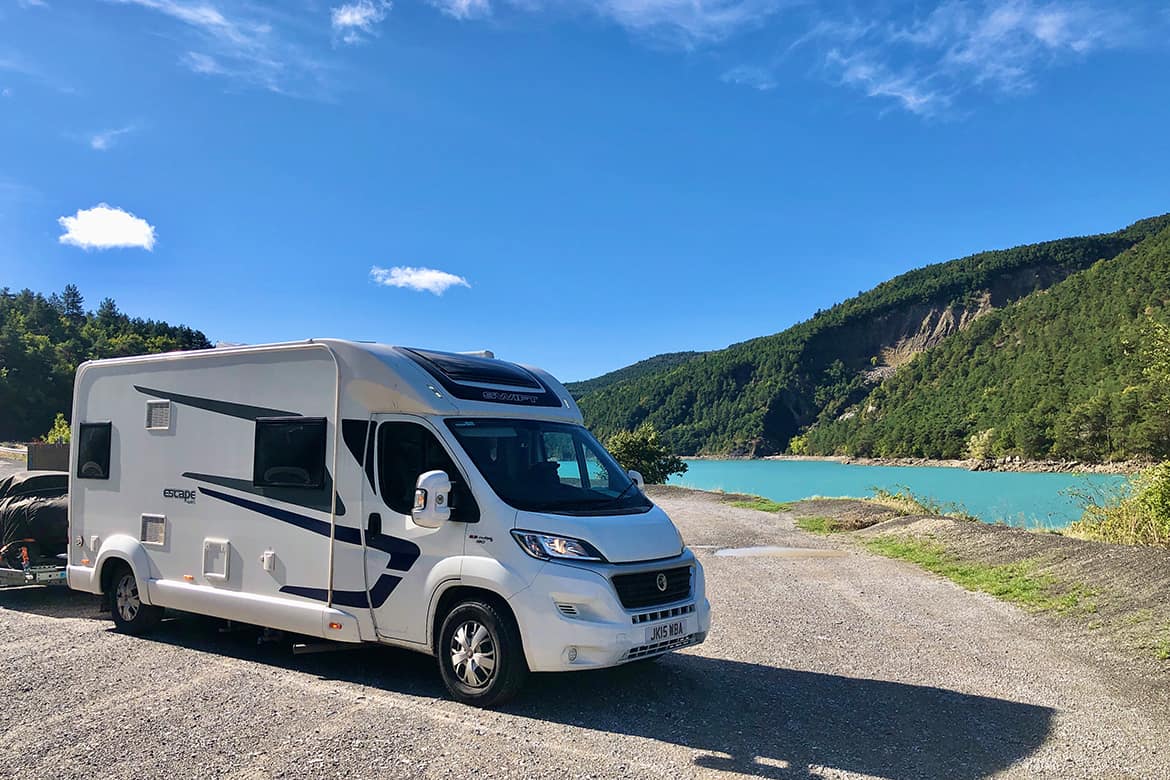
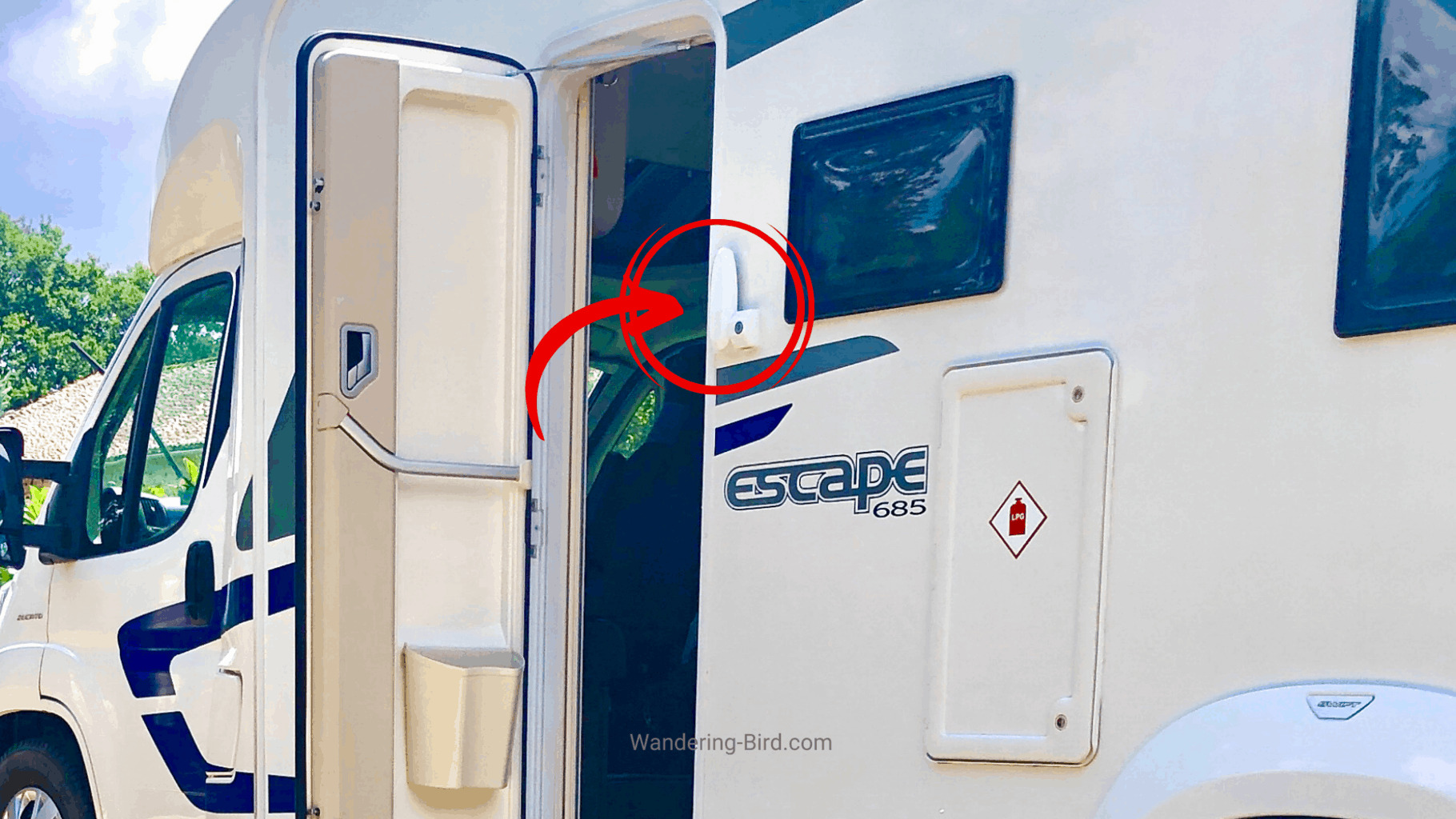



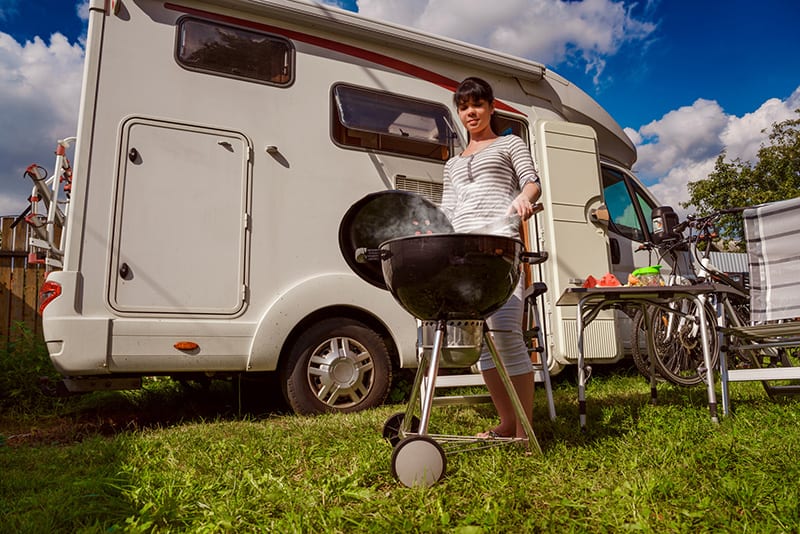
Hi
Thank you for an always informative and helpful site. Jackery and Ecoflow equipment are brill ideas in principle, but I would personally like to see equipment that would need less charging (that is, one charge up lasting longer) and overall improved longevity of this type of battery. Also, cost v amount of recharges achievable (especially as batteries can’t be replaced). I personally will wait till they get cheaper
very clear and good article easy to understand. Thank you